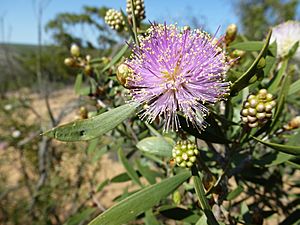Melaleuca campanae facts for kids
Quick facts for kids Melaleuca campanae |
|
|---|---|
 |
|
| M. campanae flowers, buds and leaves | |
| Scientific classification | |
| Genus: |
Melaleuca
|
| Species: |
campanae
|
Melaleuca campanae is a special plant that belongs to the myrtle family, known as Myrtaceae. You can only find it growing naturally in the south-west part of Western Australia. It's a small, woody shrub that spreads out low to the ground. It looks a bit like another plant called Melaleuca eulobata. This plant has pretty pinkish flowers and long, pointed leaves. Unlike many flowers, its sepals (the leaf-like parts that protect the bud) are not separate but form a ring around the flower's edge.
Contents
What Melaleuca campanae Looks Like
Melaleuca campanae is a small shrub that usually grows low to the ground. Sometimes, it can reach about 1.5 m (5 ft) tall. Its leaves are flat and smooth, meaning they don't have hairs. They are shaped like a narrow egg, with the thinner end closer to the stem. These leaves are usually between 12–57 mm (0.5–2 in) long and 4–9.5 mm (0.2–0.4 in) wide. If you look closely, you can see many tiny oil glands on the surface of the leaves.
The flowers of Melaleuca campanae are usually pink or purple. However, their color fades quite quickly. They grow in groups or short spikes at the ends of the branches. These branches keep growing even after the flowers have bloomed. Sometimes, flowers also appear where the upper leaves meet the stem. Each flower head can be up to 27 mm (1 in) across. Inside, there are 5 to 12 small groups, with three flowers in each group.
The petals of the flowers are small, about 1.8–2.3 mm (0.07–0.09 in) long. They fall off as the flower opens up. Around the center of the flower, there are bundles of stamens (the parts that produce pollen). Each bundle usually has 7 to 11 stamens. This plant blooms in the spring. After flowering, it produces woody fruits called capsules. These capsules are small, about 2.5–3 mm (0.1–0.1 in) long. They form almost round clusters, about 8–12 mm (0.3–0.5 in) wide, around the stem.

How Melaleuca campanae Got Its Name
The plant Melaleuca campanae was officially described in 1999. Two scientists, Lyndley Craven and Brendan Lepschi, wrote about it in a science journal called Australian Systematic Botany. They found the first plant specimen near Kalbarri.
The second part of its scientific name, campanae, comes from the Latin word campana, which means "bell." This name was chosen to honor the Bellairs family, who live in Kalbarri.
Where Melaleuca campanae Grows
You can find this type of melaleuca plant near the coast in Western Australia. It grows in the areas between Kalbarri and Geraldton. These areas are known as the Geraldton Sandplains and Yalgoo biogeographic regions. It likes to grow in sandy soil and limestone. You can also find it on exposed sandstone cliffs, often in thick, bushy areas called heath.
Conservation Status
The good news is that Melaleuca campanae is currently listed as "not threatened." This means that the Government of Western Australia's Department of Parks and Wildlife believes there are enough of these plants, and they are not at risk of disappearing.


